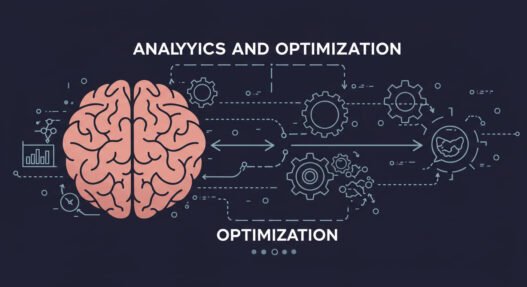How to Use Google Analytics to Drive Business Growth
Google Analytics for business growth transforms raw website data into strategic insights that directly impact revenue, customer acquisition, and competitive positioning. After implementing growth-focused analytics strategies across hundreds of businesses, the companies achieving 40-60% year-over-year growth consistently use Google Analytics not just for reporting, but as their primary business intelligence platform for making data-driven decisions.
The difference between businesses that struggle with stagnant growth and those scaling rapidly lies in how they interpret and act on Google Analytics data. Successful companies don’t just track visitors and pageviews—they identify high-value customer segments, optimize conversion paths, and discover untapped revenue opportunities that competitors miss entirely.
Business growth analytics requires shifting from vanity metrics to actionable insights that inform strategic decisions about marketing investments, product development, and customer experience optimization. The most successful businesses treat Google Analytics as their growth engine, using sophisticated analysis to identify precisely which activities drive profitable results and which waste resources on activities that feel productive but don’t impact the bottom line.
Strategic Google Analytics Setup for Growth
Google Analytics setup for business growth requires configuration that captures meaningful business data rather than generic website statistics. Most businesses miss growth opportunities because they track the wrong metrics or fail to connect web analytics to actual business outcomes.
Google Analytics goals should align directly with business objectives: lead generation, product sales, newsletter subscriptions, or consultation bookings. Without proper goal configuration, Google Analytics provides interesting data but no actionable insights for growth optimization.
Enhanced ecommerce tracking enables detailed analysis of customer purchase behavior, product performance, and revenue attribution that informs inventory decisions, pricing strategies, and marketing budget allocation. This setup transforms Google Analytics from traffic measurement tool into comprehensive business intelligence platform.
Custom dimensions and metrics capture business-specific data that standard Google Analytics doesn’t track: customer lifetime value, lead source quality, product categories, or subscription types. These customizations enable analysis that competitors using basic tracking cannot access.
Google Analytics 4 migration provides advanced machine learning insights, cross-device tracking, and privacy-compliant measurement that supports modern business growth requirements. GA4’s event-based tracking model better captures customer journey complexity than traditional pageview-focused analytics.
Audience Segmentation for Growth Opportunities
Google Analytics audience analysis reveals high-value customer segments that drive disproportionate business value, enabling focused marketing and product development that maximizes return on investment.
Customer segmentation in Google Analytics should identify behavioral patterns that predict purchase likelihood, lifetime value, and referral potential. Segments might include frequent purchasers, high-engagement visitors, or users from specific geographic markets that convert at higher rates.
Demographic analysis reveals which age groups, genders, and interests generate the most valuable customers, informing advertising targeting, content strategy, and product positioning that attracts similar prospects.
Geographic performance analysis identifies markets with untapped growth potential or regional preferences that guide expansion decisions, pricing strategies, and localized marketing approaches.
User behavior segments based on engagement depth, visit frequency, and conversion actions help prioritize marketing efforts on audiences most likely to generate business value rather than spreading resources across all website visitors equally.
Conversion Path Analysis and Optimization
Google Analytics conversion tracking reveals the complete customer journey from initial awareness through purchase, identifying optimization opportunities at each stage that can dramatically improve business results.
Multi-channel funnels in Google Analytics show how different marketing channels work together to drive conversions, preventing over-attribution to last-click interactions while revealing the full customer acquisition process.
Attribution modeling helps understand which touchpoints deserve credit for conversions, enabling more accurate ROI calculation and budget allocation across marketing channels and campaigns.
Goal flow analysis identifies where potential customers exit conversion processes, revealing specific pages, forms, or steps that prevent business growth through optimization barriers that frustrate users.
Enhanced ecommerce reports provide detailed insights into shopping behavior, product performance, and checkout abandonment that inform e-commerce optimization strategies focused on revenue growth rather than traffic increases.
Revenue Attribution and ROI Analysis
Google Analytics revenue tracking connects marketing activities to actual sales results, enabling precise ROI calculation that guides budget allocation and strategy development based on profitable results rather than activity metrics.
Marketing channel analysis reveals which sources drive the highest-value customers, longest-term relationships, and most profitable sales, informing investment decisions that maximize business growth rather than just website traffic.
Campaign ROI analysis in Google Analytics shows which specific marketing efforts generate positive returns, enabling budget reallocation from underperforming activities to high-growth opportunities.
Customer lifetime value analysis helps identify acquisition channels and customer segments that provide the best long-term business value, shifting focus from immediate conversions to sustainable growth through valuable customer relationships.
Product performance analysis reveals which offerings drive revenue, attract new customers, and encourage repeat purchases, informing inventory, pricing, and promotional decisions that optimize business profitability.
Content Strategy and SEO Growth Analysis
Google Analytics content analysis identifies which content attracts qualified traffic, engages visitors effectively, and drives conversions, informing content strategy that supports business growth objectives.
Organic search performance tracking shows which keywords and content types generate valuable traffic from search engines, guiding SEO and content development that improves search visibility and qualified lead generation.
Content engagement metrics reveal which topics, formats, and approaches resonate with target audiences, enabling content optimization that builds authority while attracting prospects likely to become customers.
Internal search analysis shows what visitors seek on your website, identifying content gaps, product interests, and service needs that represent business development opportunities.
Page performance analysis reveals which content supports conversion goals versus content that consumes resources without contributing to business growth, enabling resource reallocation toward high-impact activities.
Customer Acquisition Cost and Efficiency
Google Analytics acquisition analysis calculates the true cost of acquiring customers through different channels, enabling optimization of marketing spend toward most efficient growth strategies.
Channel efficiency analysis compares customer acquisition costs across paid advertising, organic search, social media, and referral sources to identify the most cost-effective growth channels for your specific business.
Campaign cost analysis integrates Google Analytics data with advertising spend to calculate accurate cost-per-acquisition metrics that inform budget allocation decisions and campaign optimization priorities.
Lifetime value to acquisition cost ratios help identify sustainable growth channels that generate positive returns over customer relationships rather than just immediate conversions that may not justify acquisition investments.
Lead quality analysis compares conversion rates and customer value across different traffic sources, revealing which channels attract prospects most likely to become valuable long-term customers.
Mobile and Device Optimization for Growth
Google Analytics mobile analysis reveals how smartphone and tablet users interact with your business differently than desktop visitors, identifying optimization opportunities that capture mobile-driven growth.
Mobile conversion analysis shows how purchase behavior differs across devices, informing mobile optimization strategies that remove barriers preventing mobile users from completing desired actions.
Device performance comparison identifies technical issues or user experience problems that prevent certain device types from converting effectively, addressing barriers that limit potential business growth.
Mobile traffic trends help predict future user behavior changes and optimize accordingly, ensuring business growth strategies align with evolving customer preferences and technology adoption patterns.
Cross-device tracking reveals how customers research on mobile devices before purchasing on desktop computers, enabling attribution accuracy that informs comprehensive marketing strategies.
Competitive Analysis and Market Opportunities
Google Analytics benchmarking compares your performance against industry standards, identifying areas where improved performance could drive competitive advantages and market share growth.
Market share analysis using Google Analytics data reveals opportunities for geographic expansion, demographic targeting, or product positioning that competitors may be missing or underserving.
Traffic source analysis identifies referral opportunities, partnership possibilities, and market channels that successful competitors use effectively, informing growth strategies based on proven market approaches.
Seasonal trend analysis reveals predictable patterns in customer behavior that enable proactive marketing, inventory management, and resource allocation that captures growth opportunities competitors miss.
Emerging market identification through Google Analytics data helps discover new customer segments, geographic markets, or product opportunities before competitors recognize and exploit these growth areas.
Automation and Smart Insights
Google Analytics Intelligence uses machine learning to identify significant changes, trends, and opportunities automatically, ensuring important growth insights aren’t missed during routine analysis.
Custom alerts in Google Analytics notify stakeholders when key metrics exceed thresholds, drop unexpectedly, or show unusual patterns that require immediate attention for business protection or opportunity capture.
Automated reporting ensures stakeholders receive regular updates on growth metrics without manual report generation, enabling consistent monitoring that identifies trends early enough for strategic response.
Smart goals leverage Google’s machine learning to identify high-quality sessions and optimize for valuable visitor engagement even when traditional conversion tracking isn’t possible or comprehensive.
Predictive analytics features help forecast future performance trends and identify factors most likely to influence business growth, enabling proactive strategy adjustments rather than reactive responses to problems.
Integration with Business Intelligence
Google Analytics data export enables integration with business intelligence platforms, CRM systems, and financial analysis tools that provide comprehensive business insights beyond web analytics alone.
Data Studio integration creates comprehensive dashboards that combine Google Analytics data with other business metrics for holistic growth analysis and stakeholder reporting.
CRM integration connects website behavior data with sales outcomes, customer service interactions, and retention metrics for complete customer lifecycle analysis that informs growth strategies.
E-commerce platform integration combines Google Analytics insights with inventory, pricing, and customer data for comprehensive business optimization that drives revenue growth through data-driven decisions.
Marketing automation integration uses Google Analytics data to trigger personalized campaigns, segment customers, and optimize nurturing sequences based on actual behavior patterns rather than assumed preferences.
Advanced Analysis Techniques
Cohort analysis in Google Analytics tracks customer behavior over time, revealing retention patterns, lifetime value trends, and growth sustainability metrics that inform long-term business strategy development.
User flow analysis shows exactly how visitors navigate websites, identifying optimization opportunities that remove friction from conversion paths and improve user experience quality.
Attribution modeling experiments help understand which marketing touchpoints deserve credit for conversions, enabling accurate ROI calculation and budget optimization across complex customer journeys.
Segmentation analysis reveals behavior patterns within customer groups that inform personalized marketing, product development, and service delivery approaches that drive higher customer satisfaction and growth.
Statistical analysis of Google Analytics data identifies correlations and trends that inform strategic decisions about pricing, inventory, marketing timing, and resource allocation based on data rather than assumptions.
Actionable Reporting and Decision Making
Google Analytics reporting for business growth should focus on metrics that inform strategic decisions rather than comprehensive data summaries that overwhelm stakeholders without providing clear action steps.
Executive dashboards should highlight key growth indicators, trend changes, and opportunity alerts while providing drill-down capabilities for detailed analysis when strategic decisions require additional context.
Performance KPIs should connect directly to business objectives with clear targets and progress tracking that enables accountability and strategic adjustment based on actual results rather than activity levels.
ROI reporting demonstrates how Google Analytics insights drive business value through improved marketing efficiency, conversion optimization, and customer acquisition strategy that generates measurable returns.
Strategic recommendations should translate Google Analytics data into specific business actions with expected impact estimates and implementation priorities based on resource requirements and growth potential.
Building Data-Driven Growth Culture
Analytics-driven decision making requires organizational commitment to using Google Analytics data for strategic choices rather than relying on intuition, personal preferences, or outdated assumptions about customer behavior.
Team training on Google Analytics analysis ensures consistent data interpretation and enables distributed decision-making that maintains quality while leveraging insights throughout the organization.
Regular review processes ensure Google Analytics data receives consistent attention and influences ongoing business strategy rather than being relegated to monthly reports that don’t impact actual business operations.
Testing culture uses Google Analytics data to design experiments, measure results, and optimize business operations through systematic improvement rather than random changes that may or may not improve performance.
Growth metrics focus ensures Google Analytics analysis prioritizes business outcomes over vanity metrics, maintaining attention on data that drives actual business value rather than impressive-looking statistics.
The businesses achieving exceptional growth through Google Analytics understand that success requires strategic implementation, sophisticated analysis, and systematic action based on data insights rather than just monitoring website traffic statistics. They treat Google Analytics as essential business infrastructure that deserves ongoing investment and continuous optimization to support sustainable competitive advantages.























